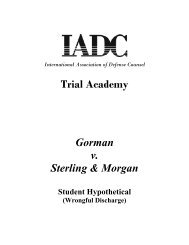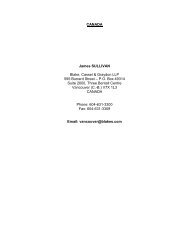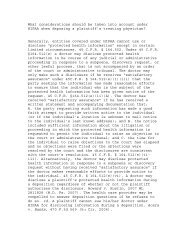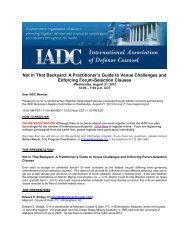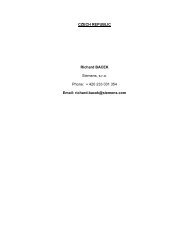Defense Counsel Journal - International Association of Defense ...
Defense Counsel Journal - International Association of Defense ...
Defense Counsel Journal - International Association of Defense ...
You also want an ePaper? Increase the reach of your titles
YUMPU automatically turns print PDFs into web optimized ePapers that Google loves.
Newsletters Page 495emissions that will counter the negativeimpacts <strong>of</strong> climate change.”The “public trust” doctrine is a legalprinciple derived from English CommonLaw. Traditionally applied to waterresources, it recognizes that the waters <strong>of</strong>the state are a public resource owned byand available to all citizens equally forthe purposes <strong>of</strong> navigation, conductingcommerce, fishing, recreation and similaruses. Such a “public trust” is notinvalidated by private ownership <strong>of</strong> theunderlying land – instead, it serves tolimit the owner’s land use to those thatwill not interfere with the public’s useand interest in resources covered by thetrust. Generally, the public trustee –usually the state – must act to maintainand enhance the trust’s resources for thebenefit <strong>of</strong> future generations.Historically, American courts haveapplied the doctrine primarily tosubmerged lands on the shores <strong>of</strong> theocean, lakes, substantial rivers andstream, to the waters above them,groundwater, and to parklands. Althoughsome decisions have extended protectionto wildlife found in public areas,migratory fowl and to dry sand beachesjust above the high tide water mark,others have refused to expand thedoctrine beyond its traditional scope.Despite the narrowness <strong>of</strong> thedoctrine, environmental groups hope touse the elasticity <strong>of</strong> the “common law” toexpand its application beyond its historiclimitations. They argue that, like water,the atmosphere, which comprises the airwe breathe, is a legitimate “public trust” –one which imposes fiduciary obligationsupon the state as the trustee <strong>of</strong> theatmosphere for the public good. In manyrespects, these cases mark the “secondwave” <strong>of</strong> climate change litigation. The“first wave” sought – so farunsuccessfully – to regulate emissions orobtain damages caused by greenhouse gasemissions using the ancient common lawtort <strong>of</strong> public nuisance. 3Many legal experts have been unsurewhether an “atmospheric trust” can becreated and used successfully to combat“atmospheric” problems, such as climatechange caused by greenhouse gasemissions. Overall, courts have beenunwilling to expand the public trustdoctrine to impose public trust dutiesexcept in conjunction with a federalstatute or as required by a statute itself.Not surprisingly then, courts in severalstates, including Colorado, Oregon,Arizona, Washington, Arkansas, andMinnesota have dismissed these types <strong>of</strong>cases early on, finding no basis for an“atmospheric trust” under state commonlaw.The United States Supreme Court hasraised even greater obstacles to thedoctrine’s expansion. Even if a court iswilling to consider expanding the “publictrust” doctrine to address climate change,it must address the “displacement” orpreemption <strong>of</strong> common law remediesrecognized in American Electric PowerCompany v. Connecticut. 4 In thatdecision, the Supreme Court held that theClean Air Act and EPA’s implementation<strong>of</strong> the Act displaced any federal commonlawright to seek abatement <strong>of</strong> carbondioxide emissions from fossil-fuel fired3 See generally, Richard O. Faulk, UncommonLaw: Ruminations on Public Nuisance, 18MO. ENVTL. L. & POL’Y REV. 1, 13-22 (2011)(analyzing the propriety <strong>of</strong> public nuisance toredress climate change claims).4 564 U.S. ___ (2011).



